#syngnathidae
Text
Today is Wet Beast Wednesday!
Today’s wet beast is: Pipefish
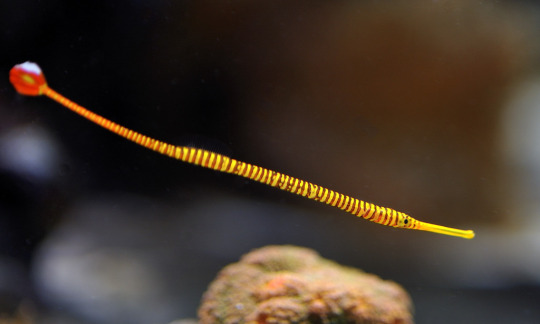
Olive’s wet beast fact: You’re probably thinking that these worm-on-a-string lookin ass creatures look like straightened seahorses. That’s bc they are part of the Syngnathidae family with Seahorses and Sea Dragons. Funky!
Stay tuned for more Wet Beast Wednesdays!
#pipefish#banded pipefish#syngnathidae#wet beast wednesday#fish#aquarium#sharks#marine biology#oceanposting#deep sea#sea creatures#ocean#sea horse#seahorse#fishblr#fishes#science#biology
8K notes
·
View notes
Note
dragons are real! they're just aquatic and live among the fishes, i saw some at an aquarium back when i was on vacation :]
(you know what i'm talking about right i'm not trying to request false creature i just think its cool)
Yes, yes, there are 3 species of sea dragons...
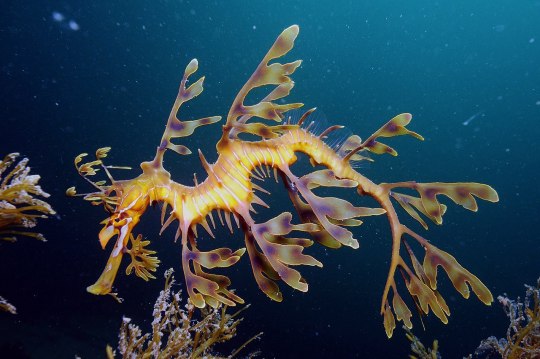
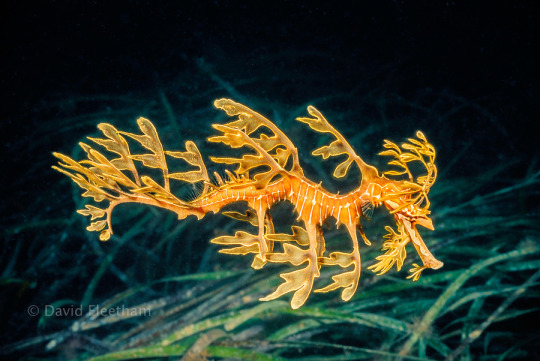
Leafy Seadragon (Phycodurus eques), family Syngnathidae, order Syngnathiformes, found off the Southern and Western coasts of Australia
photographs by Dave Fleetham & James Rosendale

Common Seadragon or Weedy Seadragon (Phyllopteryx taeniolatus), family Syngnathidae, order Syngnathiformes, found along the southern coast of Australia
photograph by John Sear
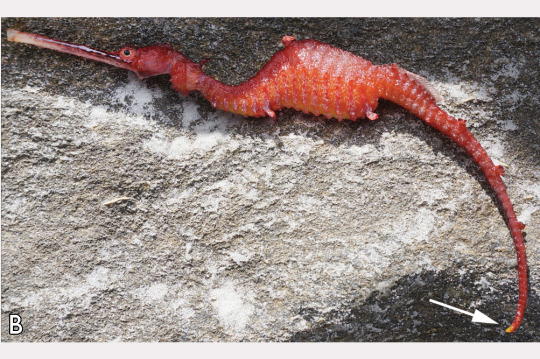

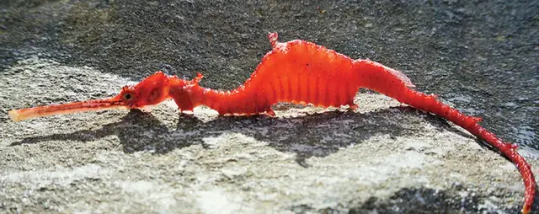
Ruby Seadragons (Phyllopteryx dewysea), family Syngnathidae, order Syngnathiformes, found off the coast of western Australia
photographs by Zoe Della Vedova
#seadragon#phyllopteryx#phycodurus#syngnathidae#syngnathiformes#fish#ichthyology#ocean#animals#nature#australia
407 notes
·
View notes
Text

A common seadragon (Phyllopteryx taeniolatus) against the kelp in Manly, Sydney, Australia.
by John Turnbull
#common seadragon#seadragons#seahorses#bony fish#fish#phyllopteryx taeniolatus#phyllopteryx#Syngnathidae#Syngnathiformes#Actinopterygii#chordata#wildlife: australia#wildlife: oceania
316 notes
·
View notes
Text
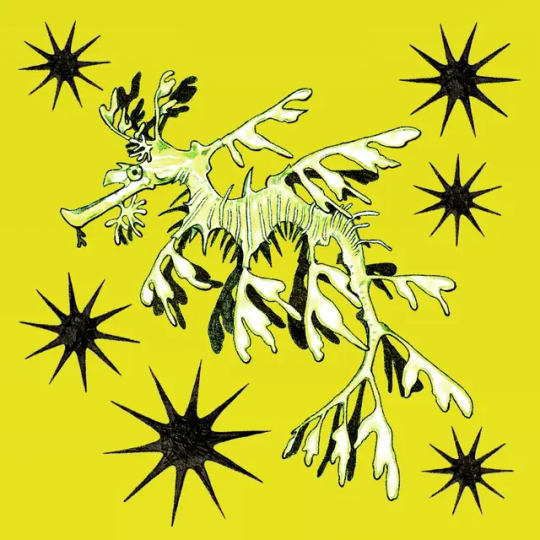

leafy seadragon 🐉🥬
1 note
·
View note
Link
#Aquariumtrade#Bonyexoskeleton#Camouflage#Conservation#Endangeredspecies#Fish#Habitatloss#Malepregnancy#Marinebiology#Reproductivebehavior#Seahorse#Syngnathidae#Temperatewaters#Tropicalwaters#Uniqueanimals#সীহর্স
0 notes
Text

Seahorse, seadragon, and pipefish from Marcus Elesier Bloch’s Ichthyologie ou, Histoire naturelle des poissons. Berlin 1796.
Source: Harvard University, Museum of Comparative Zoology, Ernst Mayr Library (online via Biodiversity Heritage Library: https://www.biodiversitylibrary.org/item/26748).
#seahorses in art#sea dragons in art#pipefish in art#Hippocampinae in art#Syngnathidae in art#fish in art#animals in art#18th century#Bloch#biodiversity heritage library#Ernst Mayr Library
285 notes
·
View notes
Text
*remembers sea dragons exist*
3 notes
·
View notes
Text

“Entelurus aequoreus are a poor food source for seabirds such as the Atlantic puffin, Fratercula arctica.”
Still looks like an omen to build a city though.
Photography by Rebecca Nason. Quote from Goncalves, I. B. et al. (2017) Phylogeography of the snake pipefish, Entelurus aequoreus (Family: Syngnathidae) in the northeastern Atlantic Ocean. Biological Journal of the Linnean Society, XX, 1–14.
54 notes
·
View notes
Text
19 notes
·
View notes
Photo

Bigbelly Seahorse (Hippocampus abdominalis)
Family: Pipefish Family (Syngnathidae)
IUCN Conservation Status: Least Concern
Easily distinguished from other seahorse species thanks to their namesake large, rotund abdomens, Bigbelly Seahorses are found mainly in coastal waters surrounding New Zealand and southeastern Australia, where they typically remain in shallow-water habitats such as coral reefs (although they are highly adaptable, and may be found at depths of over 100 meters/328ft.) Like most seahorses they are slow-moving carnivores, spending much of their lives clinging to solid surfaces using their long prehensile (grasping) tails and ambushing small crustaceans (including shrimps, isopods, amphipods and small crabs) that pass by, generating suction to pull prey into their elongated tube-like snouts while their highly sensitive eyes (which, like the eyes of a chameleon, can move independently of one another) survey their surroundings for both prey and predators (such as skates, wrasses, cormorants and penguins.) Members of this species swim between perches by paddling slowly with their dorsal fins (which in most fish are on the dorsal/upper surface of the body, but which take the place of tail fins in seahorses) and while they are not typically social outside of mating they are not aggressive towards conspecifics, allowing for groups of Bigbelly Seahorses to gather together where prey is abundant. Bigbelly Seahorses reach maturity at around 1 year of age and will reproduce as many as 4 times in a single year; when ready to mate a male attempts to court females by inflating a pouch on his abdomen to appear larger, changing his colour to a brighter yellow and tucking his head downwards as he approaches - if the female accepts his advances she will similarly tuck in her head and change her colour, and the two will then solidify their bond by “dancing” together, swimming in circles around one another and often intertwining their tails as they do so. Once courtship is complete both partners will swim towards the surface where the male will position himself slightly below the female who will then deposit between 300 and 1000 unfertilized eggs in the inflated pouch on his belly, with the male fertilizing the eggs within his pouch and carrying them with him as they develop for around 30 days before he “gives birth” to a large number of small but completely independent young. Adult Bigbelly Seahorses can grow to be up to 30cm (11.8 inches) long from the tip of their tail to the top of their head, making them among the largest of all seahorse species.
--------------------------------------------------------------------------
Image Source: https://www.inaturalist.org/taxa/69837-Hippocampus-abdominalis
#bigbelly seahorse#seahorse#seahorses#fish#fishes#zoology#biology#icthyology#marine biology#animal#animals#wildlife#marine wildlife#Australian wildlife#oceanian wildlife#New Zealand wildlife
94 notes
·
View notes
Text



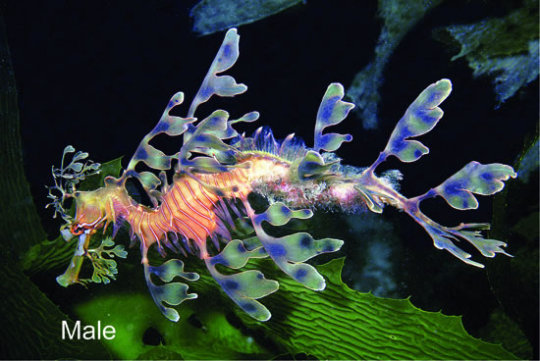


Leafy Sea Dragon (Phycodurus Eques)
The leafy seadragon (Phycodurus eques) or Glauert's seadragon, is a marine fish. It is the only member of the genus Phycodurus in the family Syngnathidae, which includes seadragons, pipefish, and seahorses.
It is found along the southern and western coasts of Australia. The name is derived from their appearance, with long leaf-like protrusions coming from all over the body. These protrusions are not used for propulsion; they serve only as camouflage. The leafy seadragon propels itself by means of a pectoral fin on the ridge of its neck and a dorsal fin on its back closer to the tail end. These small fins are almost completely transparent and difficult to see as they undulate minutely to move the creature sedately through the water, completing the illusion of floating seaweed.
Popularly known as "leafies", they are the marine emblem of the state of South Australia and a focus for local marine conservation.
Leafy sea dragons are found on the shores of southern Australia, usually between Adelaide and Perth, hiding in seaweed, commonly in water 4-15 meters deep, but have been found deeper. The water temperature is 19 Celsius in the summer, 14 in the winter. The close relative of the leafy sea dragon, the Weedy sea dragon, is found more around Sydney, Melbourne and Tasmania - especially Sydney.
31 notes
·
View notes
Text

Love the Syngnathidae family, all my homies love the Syngnathidae family
8 notes
·
View notes
Text

Common Seadragons or Weedy Seadragons (Phyllopteryx taeniolatus), family Syngnathidae, Australia
photograph by Nicolas Remy
167 notes
·
View notes
Photo


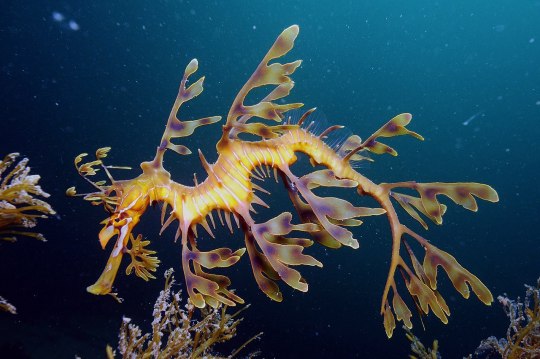


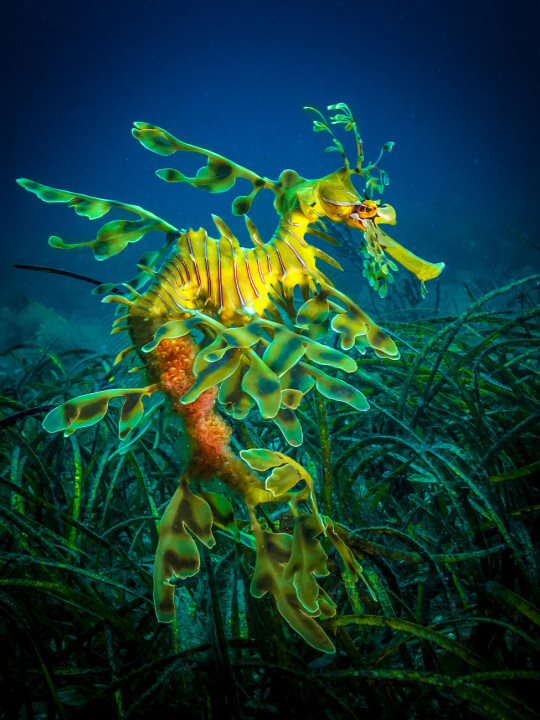
The leafy seadragon, also known as Glauert's seadragon or simply the leafie, is is a marine fish in the family Syngnathidae, which includes seadragons, pipefish, and seahorses, and is the only living member of its genus Phycodurus. They are native to the waters of the southern and western coasts of Australia where they tend to be found in sea grass meadows, sandy areas, and kelp forests up to 150ft in depth. They live alone or in pairs and feed by sucking up small crustaceans, such as amphipods and mysid shrimp, plankton, and animal larvae through its long, pipe-like snout. Sea dragons are themselves preyed upon by other fish, crustaceans and even sea anemones. Reaching 8 to 10inches (20 -25 cms) in length, there name is derived from the appearance, with long leaf-like protrusions coming from all over the body. These protrusions are not used for propulsion; they serve only as camouflage. The leafy seadragon propels itself by means of a pectoral fin on the ridge of its neck and a dorsal fin on its back closer to the tail end. These small fins are almost completely transparent and difficult to see as they undulate minutely to move the creature sedately through the water, completing the illusion of floating seaweed. In addition leafy sea dragons can change there coloration to better match there surroundings. As with other seahorses & pipefish, the male leafy seadragon cares for the eggs. The female produces up to 250 bright pink eggs, then deposits them onto the male's brood patch with her ovipositor, a long tube. After 9 weeks, the eggs turn a bright purple and begin to hatch, leaving the male to birth the young a few at a time over a period of 24-48 hours. Once born, the young seadragon is completely independent, eating small zooplankton until large enough to hunt mysids. Under ideal conditions a leafy sea dragon will reach sexual maturity at around 2 years of age and may live up to ten years.
39 notes
·
View notes
Note
I hate Syngnathidaes I had to siphon a pipefish tank and it was the worst. I hate how fragile they are, why would evolution create a fish that can break like that. I know as an aquarist I shouldn't say I hate a fish but I hate caring for any kind of Syngnathidae
Given how long and thin they are I’m not surprised that a siphon might not be the very first thing you wanna put near pipefish ^^’ I know your question is rhetorical in nature but evolution truly has no purpose, and it doesn’t matter much if an animal is fragile if it still gets to live for a while and reproduce! It’s a little silly, but if it works the bare minimum, it works.
#you can always say you dislike a fish of course. even if youre a certain profession or a hobbyist that doesnt mean you cant dislike-#-certain parts of it!#if anything you know the ins and outs of the aquarium world very well and can have nuanced opinions#asks#anonymous#anonymous asks#anon
16 notes
·
View notes
Text

I posted 17,193 times in 2022
822 posts created (5%)
16,371 posts reblogged (95%)
Blogs I reblogged the most:
@pzos-amiserableidiot
@the-king-of-lemons
@ghost-chi
@l-art-stuff-l
@hiveswap
I tagged 542 of my posts in 2022
#fish obsession pog - 25 posts
#fish of the day - 12 posts
#fish - 11 posts
#mer art - 10 posts
#queer pride mers - 10 posts
#fishblr - 9 posts
#art - 9 posts
#dream smp - 7 posts
#asks! - 6 posts
#like - 6 posts
Longest Tag: 140 characters
#there is a river running through this city i know as well as my own name. it’s the first place i’ve ever called home. i don’t think its poet
My Top Posts in 2022:
#5
Fish of the Day
Happy Tuesday everyone! Today's fish is the swordfish! Suggested by @shock-value (Another reminder that all y’all can suggest fish)

The swordfish is an amazing animal, recognized and named after the long bill extending from the top lip. Looking quite a bit like a sword as it stretches out. They belong to the family Xiphias gladius and in some countries are called "broadbills''. Swordfish reach about as large as the bluefin tuna, reaching 3 meters as well, with the largest recorded swordfish being almost 15 feet in length.
See the full post
60 notes - Posted March 8, 2022
#4
Fish of the Day
Happy Monday everyone! Today we are focusing on the Common Sea Dragon.
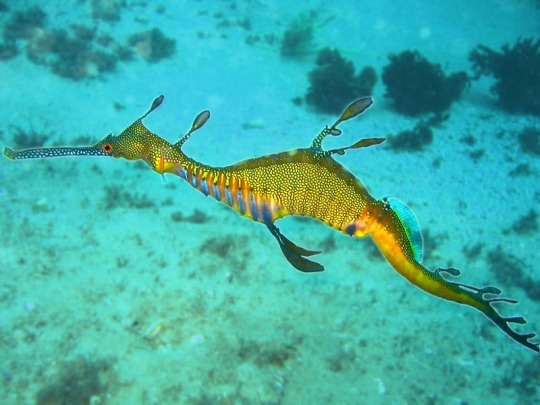
The common sea dragon, known also as the weedy sea dragon, or the leafy sea dragon, which is a misnomer as the leafy sea dragon is its own separate species. Known by the scientific name Phyllopteryx taeniolatus they are closely related to and in the same family as the seahorse, finding themselves in the Syngnathidae family.
See the full post
73 notes - Posted March 14, 2022
#3
Fish of the Day
Happy Thursday everyone! Today’s focus is the firefly squid!

The firefly squid, also known by such names as sparkling enope squid and hotaru-ika in Japan, is a deep sea wonder. Firefly squids, or Watasenia scintillans as they are known by the scientific community, are the only living squid within their family. They are commonly found in Japan around spring time and eaten there in restaurants.
See the full post
107 notes - Posted March 3, 2022
#2
Fish of the Day
Wonderful Wednesday everyone!! Today we're focusing on hagfish!! One of the most hard to biologically classify animals in the deep.

The hagfish, known by many names and few lovers, is an amazing fish. This is due to the fact we are unsure we can consider them a fish due to their strangeness. The hagfish is a deep sea, eel shaped animal that is known for its lack of bones. Known by names such as the Myxini family (also sometimes known within scientific communities as Hyperotreti), it is also referred to as slime eels. However within practical communication the name most commonly used is hagfish.
See the full post
150 notes - Posted March 2, 2022
My #1 post of 2022
Fish of the Day
Good Tuesday! Today's focus is on the gulper eel!
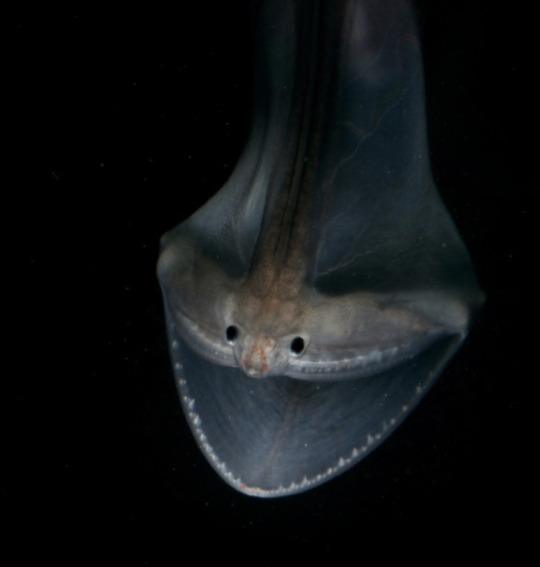
The gulper eel, also known as the pelican eel and Eurypharynx pelecanoides is a species of deep sea eel that is very rarely seen by humans due to their scarcity and their depth. They are found in the temperate and the tropical ocean around the world at the depth of 1,600 to 9,800 feet deep.
See the full post
707 notes - Posted March 1, 2022
Get your Tumblr 2022 Year in Review →
2 notes
·
View notes